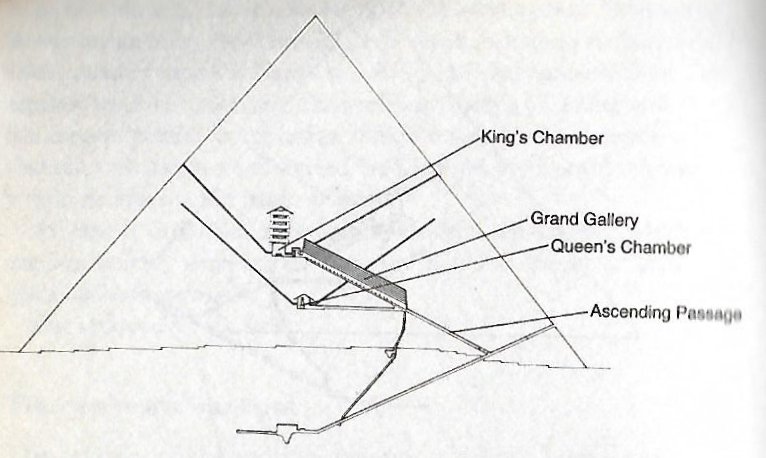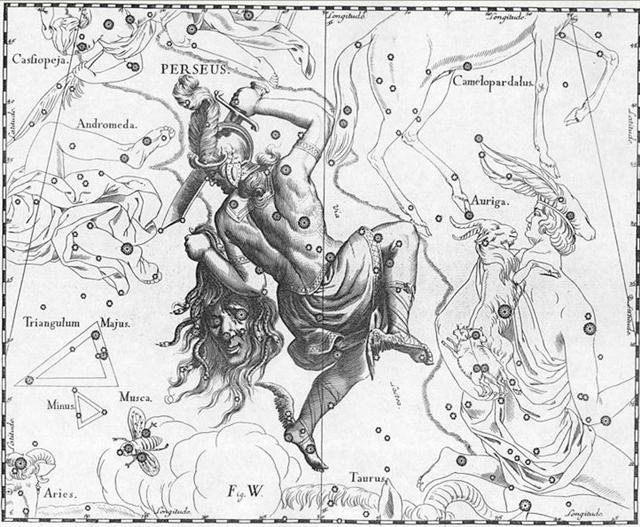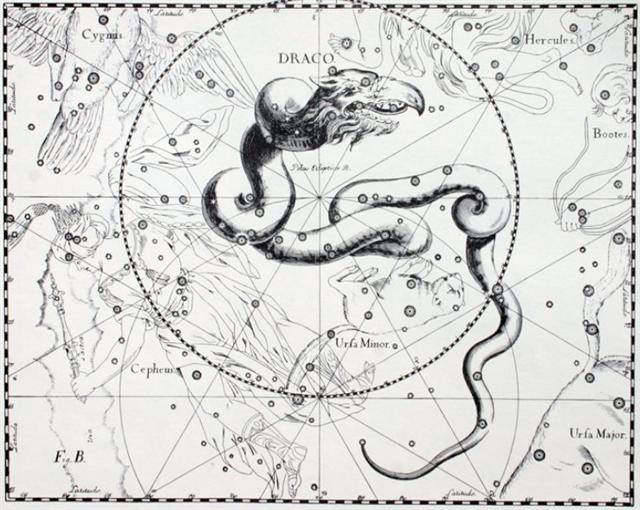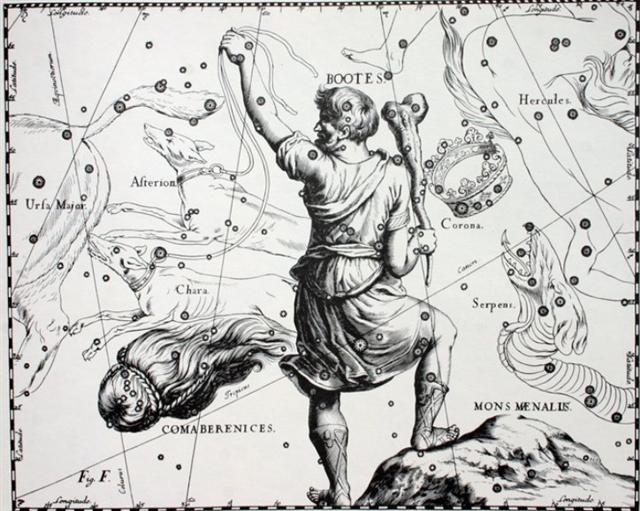308. Notably Thuban culminated (at 21h)
... The star [Thuban] could be seen, both by day and night, from the bottom of the central passage of the Great Pyramid of Cheops (Knum Khufu) at Ghizeh, in 30º of north latitude, as also from the similar points in five other like structures ...

when Rigel and Capella rose with the Sun, when the Explorers sailed away from Hiva in Vaitu Nui 25:
... [E:17] On the twenty-fifth day of the first month (Vaitu Nui), Ira and Makoi set sail; on the first day of June ('Maro'), the bow of Ira's canoe appeared on the distant horizon, came closer and closer on its course, and sailed along, and finally (one) could see the (new home) land ...

| APRIL 1 (91 = 364 / 4) |
2 (*12) |
3 |
4 (*14) |
 |
 |
 |
 |
| Ga1-11 |
Ga1-12 |
Ga1-13 |
Ga1-14 |
| HAEDUS II = η Aurigae (75.9) |
5h (76.1)
ε Leporis (76.0), CURSA = β Eridani (76.4), λ Eridani (76.7) |
μ Aurigae, μ Leporis (77.6) |
ĸ Leporis (78.0), RIGEL (Foot) = β Orionis (78.1), Flaming Star = IC405 (78.2), CAPELLA (Mother Goat) = α Aurigae (78.4), ο Columbae, τ Orionis (78.8)
THUBAN (α Draconis)
|
|
β, 2.9, topaz yellow. Cursa, 3º to the northwest of Rigel in Orion, is the principal star in this constellation, seen from the latitude of New York City. The word is from Al Kursiyy al Jauzah, the Chair, or Footstool, of the Central One, i.e. Orion, formed by β, λ, and ψ [which evidently was omitted in my star list] Eridani with [Sic!] Orionis, and regarded as the support of his left foot; but in earlier astronomy of the nomads it was one of Al Udhā al Na'ām, the Ostrich's Nest, that some extended to ο¹ and ο².
The Century Cyclopedia gives Dhalim as an alternative title, undoubtably from Al Thalīm, the Ostrich; but, although used for β by several writers, this better belong to θ. The Chinese called β Yuh Tsing, the Golden Well. |
| June 4 |
5 |
6 (157 = 314 / 2) |
7 (*78) |
| °May 31 (151) |
°June 1 (*35 + *37) |
2 |
3 |
| 'May 8 (128) |
9 |
10 (*50) |
11 |
| "April 24 (114) |
25 (*76.4 - *41.4 = *35.0) |
26 (*36) |
27 (*78.4 - *41.4 = *37.0) |
| Te Vaitu Nui 24 |
25 (113 = 115 - 2) |
26 (*36) |
27 (*78.4 - *41.4 = *37.0) |

... In view of the almost universal prevalence of the Pleiades year throughout the Polynesian area it is surprising to find that in the South Island and certain parts of the North Island of New Zealand and in the neighboring Chatham Islands, the year began with the new Moon after the early morning rising, not of the Pleiades, but of the star Rigel in Orion ...
|
| CLOSE TO THE FULL MOON: |
| OCT 1 |
2 |
3 (*196 = *13 + *183) |
4 (277) |
| 17h (258.7)
ARRAKIS = μ Draconis (258.7) |
Mula-19 (The Root)
SABIK (The Preceding One) = η Ophiuchi (259.7), η Scorpii (259.9) |
NODUS I = ζ Draconis (260.0), π Herculis (260.7), RAS ALGETHI (Head of the Giant) = α Herculis (260.8) |
SARIN = δ Herculis (261.0), ο Ophiuchi (261.4) ALRISHA (α Piscium)
|
 |
| Dec 4 |
5 |
6 (*260) |
7 |
| °Nov 30 |
°Dec 1 |
2 (*256 = *260 - *4) |
3 |
| 'Nov 7 |
8 |
9 |
10 (314 = 300 + 14) |
| "Oct 24 |
25 (300 = 295 + 5) |
26 (*196 + *23) |
27 (*220 = *261.4 - *41.4) |
| Tangaroa Uri 24 |
25 (295 = 113 + 182) |
26 (*196 + *23) |
27 (*220 = *261.4 - *41.4) |
 |
It seems not inconceivable to assume also the Chorti diviners used a lunar calendar which had the Rigel year beginning in Te Vaitu Nui 25 (113) (rather than in "April 25 (115) - or for that matter in April 25 (115).
... Later on in this series of rituals, the Chorti go through a ceremony they call raising the sky. This ritual takes place at midnight on the twenty-fifth of April and continues each night until the rains arrive. In this ceremony two diviners and their wives sit on benches so that they occupy the corner positions of the cosmic square. They take their seats in the same order as the stones were placed, with the men on the eastern side and the women on the west. The ritual actions of sitting down and lifting upward are done with great precision and care, because they are directly related to the actions done by the gods at Creation. The people represent the gods of the four corners and the clouds that cover the earth. As they rise from their seats, they metaphorically lift the sky. If their lifting motion is uneven, the rains will be irregular and harmful ...
354 - 113 - 1 = 240:
| |
Gregorian (Sun) calendar |
Moon calendar |
'helpers' |
| March (Tarahao) |
31 |
31 |
- |
| April (Vaitu Nui) |
30 |
29 |
+1 |
| May (Vaitu Potu) |
31 |
31 |
- |
| June (He Maro) |
30 |
29 |
+1 |
| July (He Anakena) |
31 |
31 |
- |
| August (Hora Iti) |
31 |
29 |
+2 |
| September (Hora Nui) |
30 |
29 |
+1 |
| October (Tangaroa Uri) |
31 |
31 |
- |
| Sum |
245 |
240 = 245 - 5 |
+5 |
| November (Ko Ruti) |
30 |
120 |
29 |
115 |
+1 |
| December (Ko Koró) |
31 |
29 |
+2 |
| January (Tua Haro) |
31 |
29 |
+2 |
| February (Tehetu'upú) |
28 |
28 |
- |
| Sum |
365 |
355 = 365 - 10 |
+10 |
The Easter Islanders explained that their month Vaitu Nui corresponded to April, but the definition of April as oriented from the stars changed when the precession moved the Sun earlier and earlier in the year. And it is still not absolutely clear if we should apply the name Vaitu Nui to the month when the Sun was in April or think of the month when the Full Moon was in April (and the Sun in October).
Furthermore, Thuban rose with the Sun - only in principle because stars close to the north pole will never rise at the horizon in the east - at the same time as when Hamal (presumably Oto Uta) was at the Full Moon.
*78 (Rigel) - *30 (Hamal) = *48. Therefore 115 (Te Vaitu Nui 27) - 48 = 67 (Tarahao 10). The Rigel year was beginning 48 days after Hamal.
| 124 |
AUG 7 (219) |
8 (*140) |
9 |
10 |
11 |
12 (224) |
13 (*145) |
 |
 |
 |
 |
 |
 |
 |
| Ga5-29 |
Ga5-30 |
Ga6-1 |
Ga6-2 |
Ga6-3 |
Ga6-4 |
Ga6-5 (145) |
| 71 VIRGINIS (203.6) |
no star listed (204) |
HEZE = ζ Virginis (205.0), Southern Pinwheel Galaxy = M83 Hydrae (205.7) |
ε Centauri (206.3), κ Oct. (206.4) |
no star listed (207) |
τ Bootis (208.2),
BENETNASH (Leader of the Daughters of the Bier) = η Ursae Majoris (208.5), ν Centauri (208.7), μ Centauri, υ Bootis (208.8) |
no star listed (209) |
 |
| Oct 10 |
11 (284) |
12 (285) |
13 |
14 |
15 (*208) |
16 |
| °Oct 6 |
7 (280) |
8 |
9 |
10 |
11 (*204) |
12 (285) |
| 'Sept 13 (256) |
14 (*177) |
15 |
16 |
17 (260) |
18 |
19 (*182) |
| "Aug 30 (242) |
31 (284 - 41) |
"Sept 1 (*164) |
2 |
3 |
4 |
5 (*168) |
| 122 |
Hora Nui 1 (238) |
2 (284 - 45) |
3 (*164) |
4 |
5 (242 = 260 - 18) |
6 |
7 (225 + 19) |
| CLOSE TO THE FULL MOON: |
| 124 |
FEBR 6 (*322) |
7 (403) |
8 (*324) |
9 (40) |
10 |
11 |
12 (408) |
| δ Phoenicis (21.5) |
υ Andromedae (22.9) |
ACHERNAR (End of the River) = α
Eridani (23.3), χ Andromedae (23.6), τ Andromedae (23.9) |
ALSEIPH (Scimitar) = φ Persei (24.5), τ Ceti (24.7) |
no star listed (25) |
ANA-NIA-10 (Pillar-to-fish by)
χ Ceti (26.1), POLARIS = α Ursae Minoris, BATEN KAITOS (Belly of the Fish) = ζ Ceti (26.6), METALLAH = α Trianguli (26.9) |
Al Sharatain-1 (Pair of Signs) / Ashvini-1 (Horse's Head) / Bond-16 / Mahrū-sha-rishu-ku-1 (Front of the Head of Ku)
SEGIN = ε Cassiopeia, MESARTHIM = γ Arietis, ψ Phoenicis (27.2), SHERATAN (Pair of Signs) = β Arietis, φ Phoenicis (27.4) |
 |
| April 11 (101) |
12 (*387) |
4-13 |
14 |
15 |
16 (471) |
17 (107) |
| °April 7 (97) |
8 (*383) |
9 |
10 (100) |
11 |
12 (*22) |
13 |
| 'March 15 (74) |
16 (*360) |
17 |
18 |
19 (78) |
20 (*364) |
0h |
| "March 1 (60) |
2 (*346) |
3 |
4 |
5 (64) |
6 (*350) |
7 |
| 125 |
Tarahao 1 (423) |
2 (*163 + *183) |
3 (60 = 240 - 180) |
4 |
5 (64 - 2) |
6 (*350) |
(64 = 29 + 28 + 7) |
| AUG 14 |
15 |
16 (*148) |
17 (229) |
18 |
19 |
 |
 |
 |
 |
 |
 |
| Ga6-6 |
Ga6-7 |
Ga6-8 |
Ga6-9 |
Ga6-10 (151) |
Ga6-11 |
| MUPHRID (Solitary Star) = η Bootis (210.1), ζ Centauri (210.3) |
φ Centauri (211.0), υ¹ Centauri (211.1), υ² Centauri (211.8), τ Virginis (211.9) |
AGENA (At the Knee) = β Centauri (212.1), θ Apodis (212.5), THUBAN (Dragon) = α Draconis (212.8) |
14h (213.1)
π Hydrae, χ Centauri (213.0), MENKENT (Shoulder of the Centaur) = θ Centauri (213.1) |
Neck-2 (Dragon)
ASELLUS TERTIUS (3rd Ass Colt) = κ Bootis, κ Virginis, 14 Bootis (214.8) |
Al Ghafr-13 (Covering) / Svāti-15 (Very Good) / TAHUA-TAATA-METUA-TE-TUPU-MAVAE-6 (a pillar to stand by) 15 Bootis (215.2), ARCTURUS = α Bootis (215.4), ASELLUS SECUNDUS (2nd Ass Colt) = ι Bootis (215.5), SYRMA (Train of the Virgin's Robe) = ι Virginis, λ Bootis (215.6), η Apodis (215.8) |
 |
| Oct 17 (290) |
18 |
19 |
20 |
21 (*214) |
22 |
| °Oct 13 |
14 |
15 (*208) |
16 |
17 (290) |
18 |
| 'Sept 20 |
21 |
EQUINOX |
23 (*186) |
24 |
25 (268) |
| "Sept 6 |
7 |
8 |
9 (*172) |
10 |
11 (254) |
| Hora Nui 8 (245) |
9 |
10 |
11 (*172) |
12 |
13 (250) |
| CLOSE TO THE FULL MOON: |
| FEBR 13 |
2-14 (45) |
15 |
16 (*332) |
17 (413) |
18 |
| ι Arietis (28.0), λ Arietis (28.2), υ Ceti (28.8) |
ALRISHA (The Knot) = α Piscium, χ Phoenicis (29.2), ALAMAK (Caracal) = γ Andromedae (29.7) |
Arku-sha-rishu-ku-2 (Back of the Head of Ku)
2h (30.4) κ Arietis (30.3), HAMAL (Sheep) = α Arietis (30.5)
ALKES (α Crateris)
|
η Arietis (31.9) |
ξ¹ Ceti (32.1) |
χ Persei (33.2), θ Arietis (33.3), MIRA (Next to the Pleiades) = ο Ceti (33.7) |
 |
| April 18 (473) |
19 |
20 (*395) |
21 (111) |
22 |
23 |
| 4-14 |
°April 15 |
16 (471) |
17 (107) |
18 |
19 |
| 'March 22 |
23 |
24 (*368) |
EQUINOX |
26 (85) |
27 |
| "March 8 (67) |
9 |
10 (*354) |
11 |
12 |
13 (72 = 360 / 5) |
| Tarahao 8 (65) |
9 |
10 (*354) |
11 |
12 |
13 (70 = 350 / 5) |
Possibly the pair of sitting figures (back to back as if a sign similar to that of Janus) indicated the point which at the time of Julius Caesar could have marked where the old year ended and a new year was beginning. 'March 25 was the Julian equinox.
 
Another and somewhat similar forward facing figure came 5 days later, looking female:
| AUG 20 |
21 |
22 |
23 (235) |
24 (*156) |
 |
 |
 |
 |
 |
| Ga6-12 |
Ga6-13 |
Ga6-14 |
Ga6-15 |
Ga6-16 (→ 366) |
| ι Lupi, 18 Bootis (216.3), KHAMBALIA (Crooked-Clawed) = λ Virginis (216.4), υ Virginis (216.5), ψ Centauri (216.6), ε Apodis (216.8) |
ASELLUS PRIMUS (1st Ass Colt) = θ Bootis (217.8) |
τ Lupi, δ Oct. (218.1), φ Virginis (218.7) FOMALHAUT (α Piscis Austrini)
|
σ Lupi (219.1), ρ Bootis (219.5), HARIS (Keeper) = γ Bootis (219.7) |
σ Bootis (220.2), η Centauri (220.4) |
|
... Al Hāris al Samā, the Keeper of Heaven, perhaps came from the star's [Arcturus] early visibility in the twilight owing to its great northern declination [19° 27′ N], as though on the lookout for the safety and proper deportment of his lesser stellar companions, and so 'Patriarch Mentor of the Train'. This subsequently became Al Hāris al Simāk, the Keeper of Simāk, probably referring to Spica, the Unarmed One ... The word Simāk is of disputed signification, and was a fruitful subject of discussion a century ago. It is from a root meaning 'to raise on high', and is thought to have been employed by the Arabs when they wished to indicate any prominent object high up in the heavens, but with special reference to this star [Arcturus] and to the other Simāk, Spica of the Virgin ... |
 |
| Oct 23 (*216) |
24 |
25 |
26 |
27 (300) |
| °Oct 19 |
20 |
21 (*214) |
22 (295) |
23 |
| 'Sept 26 |
27 |
28 |
29 (*192) |
30 (273 = 3 * 91) |
| "Sept 12 |
13 |
14 (*177) |
15 |
16 (259) |
| Hora Nui 12 (251) |
13 |
14 (*177) |
15 |
16 |
| CLOSE TO THE FULL MOON: |
| FEBR 19 |
20 (*336) |
21 (52) |
22 (418) |
TERMINALIA |
| no star listed (34) |
ξ Arietis (35.0), ρ Ceti (35.4), ξ² Ceti (35.9) |
σ Ceti (36.9) |
ν Ceti (37.9) |
ν Arietis (38.5), δ, ε Ceti (38.8) |
| April 24 |
25 (115) |
26 (*36) |
27 |
28 (*403) |
| °April 20 |
21 (111) |
22 (*32) |
23 |
24 (*399) |
| 'March 28 |
29 (88) |
30 |
31 (*375) |
'April 1 (91 = 7 * 13) |
| 3-14 |
"March 15 |
16 (*360) |
17 |
18 (77) |
| Tarahao
14 |
15 |
16 (*360) |
17 |
18 (75) |


|























